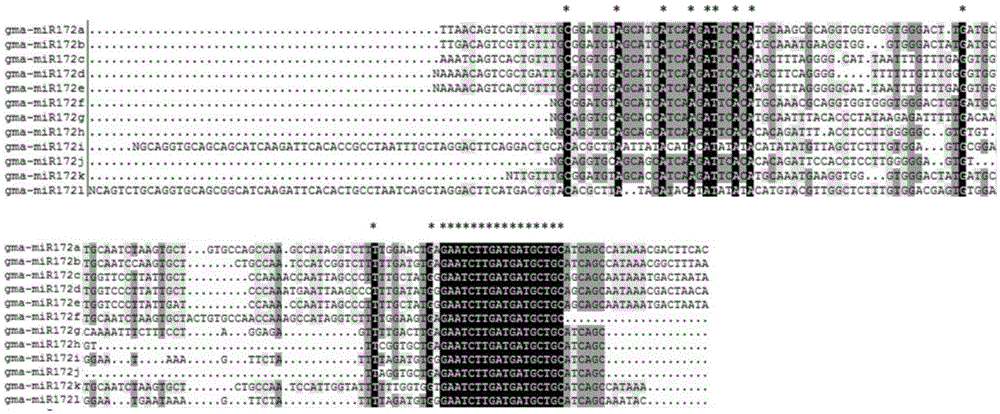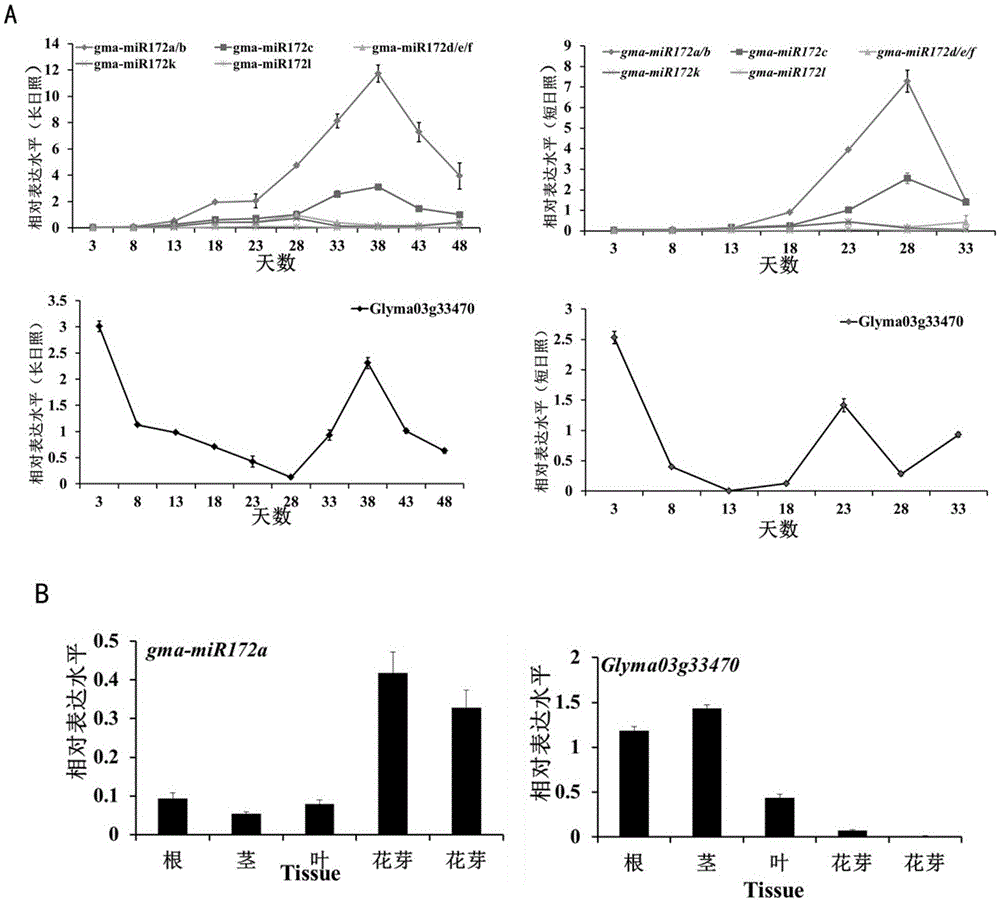Method for cultivating transgenic plants with blooming ahead of time
A technology of transgenic plants and cultivation methods, applied in the fields of botanical equipment and methods, angiosperms/flowering plants, biochemical equipment and methods, etc., can solve the problems of cultivating transgenic plants, less research on soybean miR172 family, etc., and achieve earlier flowering time. Effect
- Summary
- Abstract
- Description
- Claims
- Application Information
AI Technical Summary
Problems solved by technology
Method used
Image
Examples
Embodiment 1
[0036] Cloning and expression vector construction of embodiment 1 soybean miRNA172a
[0037] 1. According to the conserved region of the known miRNA172a gene sequence, design soybean miRNA172a primers such as SEQ ID NO.2 and SEQ ID NO.3. Perform specific PCR amplification on the whole soybean genome DNA extracted from the tissue;
[0038] 2. The product was separated by gel electrophoresis at room temperature, and a band with a size of about 159 bp was detected;
[0039] 3. The bands were recovered and purified, amplified again with the same primers and then sequenced. The result is shown in SEQ ID NO.1.
[0040] 4. Use restriction endonucleases BglⅡ and BstEII to double digest pCAMBIA3301 plasmid and pGM-T-miR172a plasmid to obtain restriction fragments; recover the large vector fragment and small miR172a gene fragment in the obtained pCAMBIA3301 restriction enzyme digestion system, and use T4DNA ligase The miR172a gene was substituted for the GUS gene on the original pCAMB...
Embodiment 2
[0041] Example 2 Sequence Analysis and Alignment of Soybean miR172 Members
[0042] The inventors compared the obtained gma-miR172 precursor sequence using DNAman software, the results are as follows figure 1 shown. From figure 1 As can be seen from , except for some conserved bases (the positions indicated by the asterisks in the figure), the inventors found that there are still some differences in the precursor sequences among the members, which may be one of the reasons for the different functions of the members.
Embodiment 3
[0043] Example 3 The expression of gma-miR172a and target gene Glyma03g33470 in soybean under different growth days, tissues and photoperiod conditions.
[0044] 1. Design primers (SEQ ID NO.7 and SEQ ID NO.8) according to the target gene Glyma03g33470 (nucleotide sequence such as SEQ ID NO.4) of soybean miR172a;
[0045]2. Use the above primers, and gma-miR172a primers SEQIDNO.2 and SEQIDNO.3 to amplify gma-miR172a and target gene Glyma03g33470 in soybean cDNA under different growth days, tissues, and photoperiod conditions, respectively;
[0046] The result is as figure 2 As shown in A. Under the conditions of different growth days, the expression level of gma-miR172a was significantly higher than that of other members, and its expression level gradually increased with the growth of the plants, and reached the peak at 38 and 28 days under long-day and short-day conditions, respectively. The expression of Glyma03g33470 has a complementary effect, and the expression level o...
PUM
 Login to View More
Login to View More Abstract
Description
Claims
Application Information
 Login to View More
Login to View More - R&D
- Intellectual Property
- Life Sciences
- Materials
- Tech Scout
- Unparalleled Data Quality
- Higher Quality Content
- 60% Fewer Hallucinations
Browse by: Latest US Patents, China's latest patents, Technical Efficacy Thesaurus, Application Domain, Technology Topic, Popular Technical Reports.
© 2025 PatSnap. All rights reserved.Legal|Privacy policy|Modern Slavery Act Transparency Statement|Sitemap|About US| Contact US: help@patsnap.com



